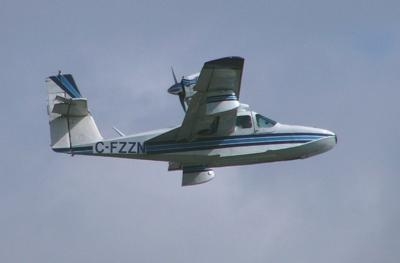Thu, Sep 05, 2013
Fuel Filter Issue May Cause Engine Surging Under Takeoff Power
The FAA has issued an SAIB for Lake Model LA-4-200 airplanes for an airworthiness concern regarding the loss of power during take-off due to inadequate fuel flow to the engine.

The FAA says it has received reports that the Lake Model LA-4-200 airplane has a history of engine events, surging, and reduction of power, which could result in accidents. The original fuel filter on this aircraft is a Bendix 450-OK, which has a 40-micron element and is rated for 20 gallons per hour (GPH). The original filter is no longer being manufactured and is mounted horizontally to the engine pylon, which prohibits sediment and water to drain properly. The original filter also does not have a bypass system in the event that the filter fuel flow is restricted.
To correct the situation, the FAA recommends replacement of the Bendix 450-OK fuel filter with a fuel filter that has a higher flow rate such as the installation of the newly designed Airmaze Filter Assembly, part number AM01W052261, which is FAA-approved for installation in the LA-4-200 and depicted on Revo Drawing L-0406 C, Revision C, dated 8/5/86. Drawing L-0406 C. This installation has a higher flow rate of 55 GPH, a 40-micron element, and bypass capabilities. This Revo drawing allows for replacement of the filter with the filter location remaining in the engine pylon.
In addition, the agency recommends relocation of the newly designed filter to a position below the center fuel tank following. FAA-approved Supplemental Type Certificate (STC) SA00333BO is another method of accomplishing this. This relocation has the added safety benefit of allowing drainage of water and sediments.
The FAA recommends this replacement or relocation of the fuel filter within the next 25 hours time-in-service (TIS). Pilots should follow the standard aircraft flight manual preflight check procedures, which include draining all fuel tank gascolators and other drainage ports. Pilots should also ensure that the fuel boost pump is engaged during take-off. The filter should be inspected and or replaced as needed at each 100-hour TIS inspection or annual inspection, as applicable.
The FAA says this airworthiness concern is not an unsafe condition that would warrant airworthiness directive action under Title 14 of the Code of Federal Regulations part 39.
(File image released to the public domain)
More News
Pilot Also Reported That Due To A Fuel Leak, The Auxiliary Fuel Tanks Were Not Used On June 4, 2025, at 13:41 eastern daylight time, a Piper PA-23, N2109P, was substantially damage>[...]
From 2023 (YouTube Edition): Reflections on War’s Collective Lessons and Cyclical Nature The exigencies of war ought be colorblind. Inane social-constructs the likes of racis>[...]
Pilot Reported That He Was Unfamiliar With The Single Seat Amateur-Built Airplane And His Intent Was To Perform High-Speed Taxi Testing Analysis: The pilot reported that he was unf>[...]
From 2023 (YouTube Edition): First Kits to Ship October 2023 Having formerly resurrected the storied shape of the Ryan ST—in effigy, anyway—Montrose, Colorado-based Tim>[...]
Performance-Based Navigation (PBN) [ICAO] Area navigation based on performance requirements for aircraft operating along an ATS route, on an instrument approach procedure or in a d>[...]
 NTSB Prelim: Piper PA-23
NTSB Prelim: Piper PA-23 Classic Aero-TV: One Mans Vietnam
Classic Aero-TV: One Mans Vietnam NTSB Final Report: Capella Aircraft Corp FW1C50
NTSB Final Report: Capella Aircraft Corp FW1C50 Classic Aero-TV: Timber Tiger Touts Curtiss Jenny Replicas
Classic Aero-TV: Timber Tiger Touts Curtiss Jenny Replicas ANN's Daily Aero-Term (07.04.25): Performance-Based Navigation (PBN) [ICAO]
ANN's Daily Aero-Term (07.04.25): Performance-Based Navigation (PBN) [ICAO]



